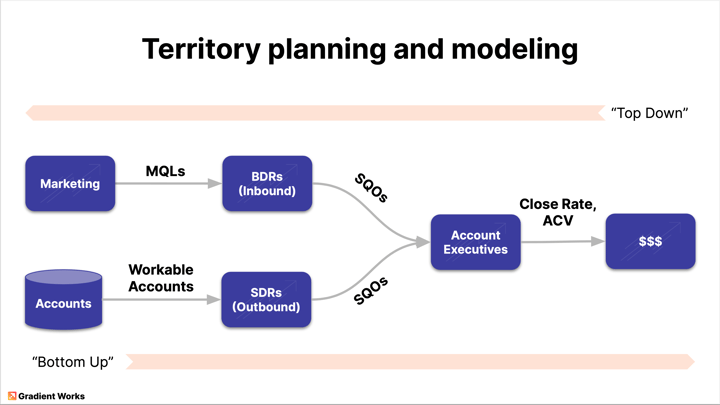Let’s talk about the best practices for sales territory and quota planning and ways to improve your sales team's account allocations.
Types of sales territories
Sales territories come in a number of different flavors. There are both static models and dynamic models. We typically break down the types of territories this way:
-
Static: Carve up your market and assign sales reps to different sections, often annually
-
Geography
-
Vertical
-
Named Accounts
-
-
Dynamic: Allocate accounts on demand
-
Round Robin
-
Dynamic Books
-
Different territory models will work for different companies, depending on the velocity and complexity of your GTM model, as well as how your deals are structured. For example, small teams can use a simple round-robin distribution model without many issues. But larger teams with higher inbound lead velocity will need something that can handle additional complexity, like dynamic books. Companies that rely on a more traditional sales model, including field sales, will probably prefer to use a more traditional static geography-based system.
There's more information about which territory design model is right for your team in the graphic below.
.png?width=960&height=540&name=New%20Talk%20Track_%20Territory%20Design%20and%202023%20Planning%20(3).png)
Sales territory planning
When you undergo sales territory planning - whether this is something you do once a year, or more regularly, you first need to understand your requirements. This requires some modeling. Should you use a top-down model or a bottom-up model in your territory planning? This image shows a simplified version of a modeling exercise for territory planning.

When territory planning for sales, a best practice we recommend to everyone is to use both top-down and bottom-up models to find where they meet in the middle and use that information for your territory plan. That means you need data on both your revenue plan as well as rep activity.
How often should you do sales territory planning? That depends a lot on the territory model you've chosen. A static geographic model generally gets carved up once a year, with some tweaks throughout the year. Dynamic models involve more regular evaluation and optimization.
Sales territory and quota planning
You often think about sales territory and quota planning together (in fact, we’re teaching a course with our friends over at Quotapath for Pavilion’s Enterprise GTM school this semester on these topics!). Territories, compensation, and sales management plans are intrinsically linked - the way you allocate quota capacity has a direct impact on rep comp. If you want more information on quota and comp planning, check out QuotaPath’s blog.
Building territories
Regardless of the model you use, you'll need to make sure your rep books are balanced. Break down your quota capacity allocations across your TAM by balancing fit and timing for accounts.
Fit
-
Goal: Determine which accounts fit your ICP better than others and should be more likely to become customers and/or better customers.
-
Inputs: Firmographic data that’s relatively easy to see externally and doesn’t change too quickly over time, e.g. country, industry, employees, revenue
-
Process: While you can use statistical or ML models, we recommend starting simple. Use a score based on weights for the different attributes.
-
Outputs: Either a score (e.g. 0-10) or a classification (e.g. A-D). We recommend starting with classification.
Timing
-
Goal: Determine which accounts are potentially looking for a solution like yours.
-
Inputs: Data that indicate interest such as marketing activity, product usage (for PLG), and/or intent from an intent data provider like 6Sense or Zoominfo.
-
Process: Some products provide an intent score but you can also use a similar weighted approach for this score.
-
Outputs: Either a score (e.g. 0-10) or a classification (e.g. A-D). We recommend starting with classification.
Hopefully, these tips on sales territory planning best practices can help you improve your own territory plan.




